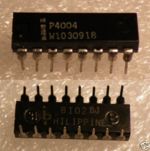Intel 4004
The Japanese company Busicom contracted Intel in 1969 to create a chip set for a printer-calculator. Busicom permitted Intel to use the chipset design for non-calculator applications (the year this happened was 1971, according to sources referenced by Wikipedia). The processor chip was called the 4004 and sold for $200. This was the first commercially available microprocessor.
The 4004 (see picture) came in a 16-pin DIP[1] and had some limitations when compared to later microprocessors. It could only execute code out of erasable ROM, RAM was only used for storing data, and this complicated the life of the programmer somewhat. The chip also needed a lot of support logic.
Data and address information was multiplexed on a 4-bit bus.
The 4004 was only the processor part of the chip set produced for Busicom. The original setup was:
- The processor (which became the 4004)
- ROM (read only memory) with I/O)
- RAM (programmable memory with I/O)
- A shift register type memory
(Note that the functionality of the parts may not be what would today be recognized as ROM and RAM, but those are presumably the closest term describing them).
References
- BYTE Volume 3, number 7, July 1978, "The First Ten Years of Amateur Computing"
- [1]Note that the BYTE article incorrectly states that the chip came in an 18-pin DIP.
